OpenAI has announced the launch of their latest innovation, GPT-4 Turbo, at a remarkable event during DevDay 2023.
With an extended context length of up to 128k, it can process and generate text more efficiently than ever before. It also integrates a functions interpreter, allowing for better code execution, and adds custom datasets as context, elevating AI to a new level!
Additionally, the Chat Completions API now accepts images as inputs, enabling use cases such as generating captions, analyzing real-world images in detail, and reading documents with figures.
In this article, we will explore the latest AI breakthrough, including its capabilities and potential to revolutionize the world of AI.
Want to know more about GPT-4 Turbo?
Join us as we demystify the future —starting right here, right now!
Overview of OpenAI’s GPT4-Turbo

GPT-4 Turbo is a new and improved version of the GPT-4 model, a powerful artificial intelligence system that can generate natural language texts. GPT-4 Turbo has several advantages over the previous model.
Let’s explore these new features In more detail:
Transformative Advances in AI Technology
OpenAI has once again raised the bar in artificial intelligence with the preview release of GPT-4 Turbo and the updated GPT-3.5 Turbo.
These models represent significant advancements in AI capabilities, offering a blend of improved efficiency, enhanced creativity, and heightened safety.
Key Features of GPT-4 Turbo
- Extended Knowledge Base: GPT-4 Turbo boasts an updated knowledge cutoff of April 2023, providing access to the most recent information, far surpassing GPT -4’s October 2022 limit.
- Expanded Context Window: With a remarkable 128k context window, equivalent to 300 pages of text, GPT-4 Turbo can process and retain information over much larger volumes.
- Versatile Image Input Handling: GPT-4 Turbo can now process images, offering capabilities like generating captions, detailed image analysis, and document reading with figures.
- Cost-Effectiveness: GPT-4 Turbo is 3X cheaper for input tokens ($0.01) and 2X cheaper for output tokens ($0.03) than GPT-4.
- Enhanced Creativity and Collaboration: The model excels in generating, editing, and iterating across various creative and technical writing tasks, adapting to user’s styles with greater finesse.
- Accuracy and Reliability: It stands out in solving complex problems with increased accuracy, leveraging broad general knowledge and enhanced problem-solving skills.
- Safety and Alignment: GPT-4 Turbo is designed to be safer and more aligned, with a reduced propensity to respond to disallowed content and a higher likelihood of generating factual responses.
GPT-4 is optimized for chat but works well for traditional completion tasks using the Chat Completions API.
Now, let’s delve into a step-by-step guide on effectively utilizing this AI model.
How to Use GPT4-Turbo

To unleash the potential of GPT-4 Turbo, ensure you have an active OpenAI account and have your API key handy for future integrations. Accessing these advanced features requires a PAID subscription; be prepared to spend at least $5 on the platform before proceeding.
Here are the steps you need to follow:
1. Create an OpenAI Account
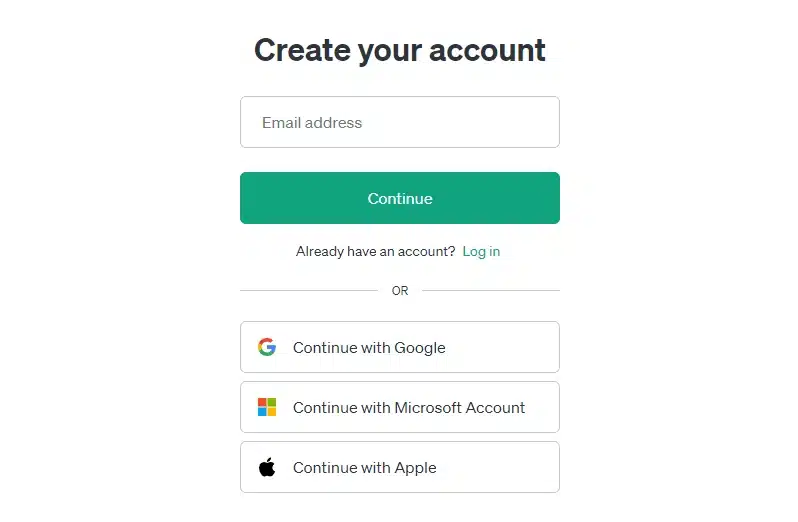
Create an account on the OpenAI website. You will need to provide your email address, name, and password. You must also agree to the terms of service and privacy policy.
2. Add Payment Details to Unlock GPT4

Next, go to “Settings > Billing > Add Payment Details.” Once you’ve added your payment details and purchased at least 5$ worth of credits, GPT4Turbo is unlocked!
3. Navigate To the Playground
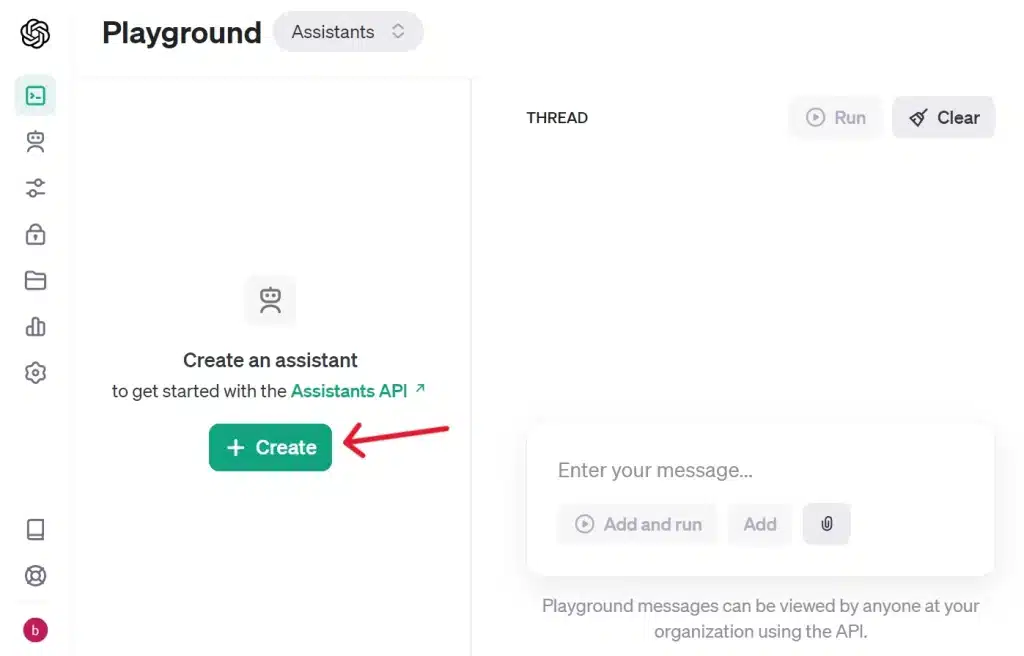
Now that you’ve activated GPT4, it’s time to access the OpenAI Playground. Here, you can try out different models and features. You will also see a dashboard with your usage statistics and billing information.
4. Customize your Assistant
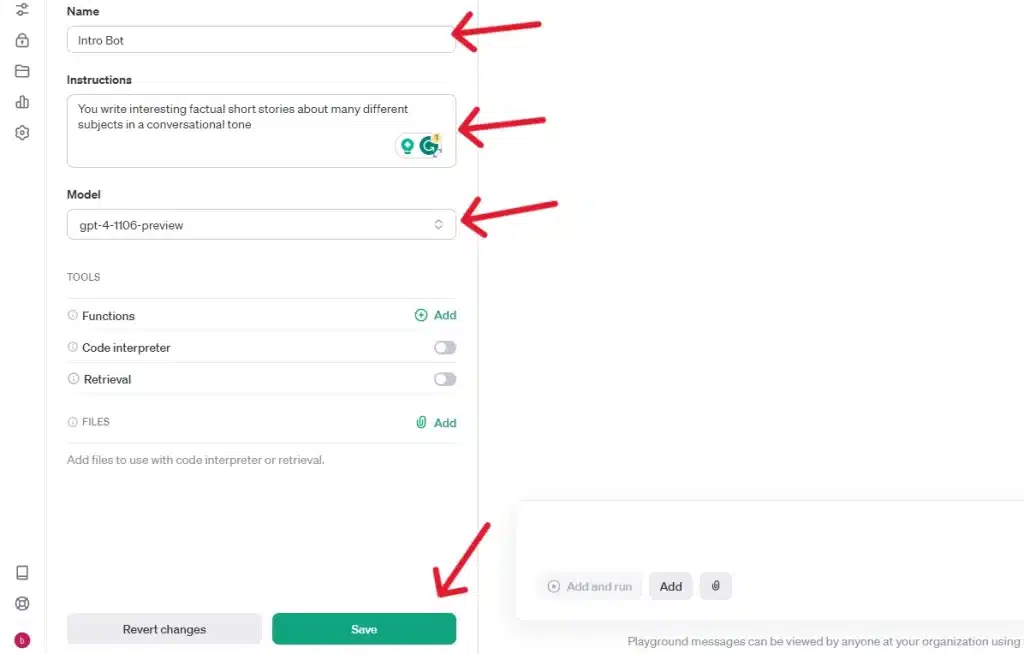
Click the “+ Create” button to start creating your first assistant. Now, enter the name of your model and the instructions for what your model will do.
There are options to add functions, use the code interpreter, and retrieve where you can upload and interact with your files.
Select “gpt-4-11-6-preview” from the list. (AKA GPT-Turbo, this name model name may change over time as this is a preview edition).
Select “Save” to confirm your custom assistant settings.
5. Add and run your model
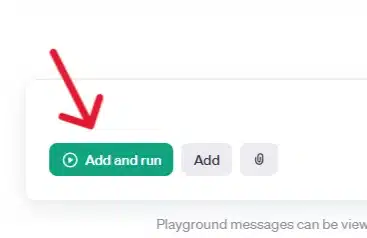
Now, you can select “add and run” to load your custom assistant.
6. Testing Your Model
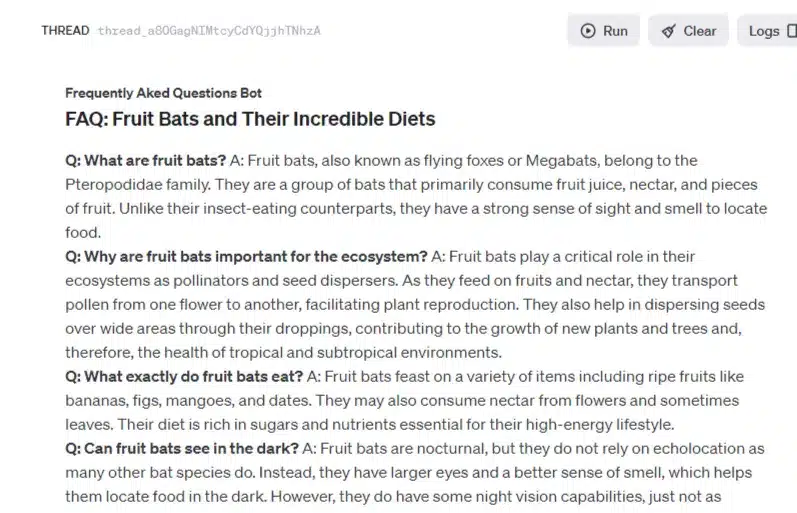
Start typing where it says, “Enter your message”. Now, you can prompt the model like any other chatbot-styled LLM. Then select “add and run”.
Now, you should see the model outputting according to your earlier instructions.
7. Add Custom Functions
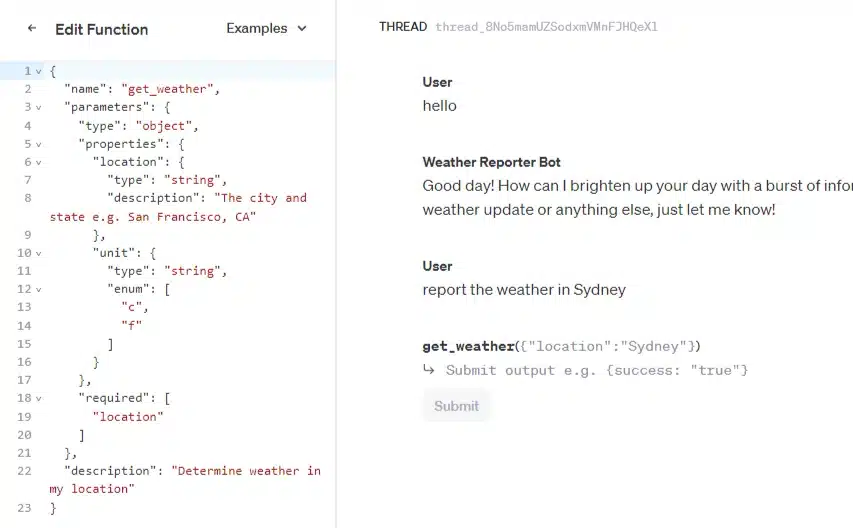
This feature allows you to describe custom functions of your app or external APIs to the assistant. It enables the assistant to intelligently call those functions by outputting a JSON object containing relevant arguments.
The assistant will then use this JSON object to call your getWeather function and pass the specified region as an argument. This makes it easy for the assistant to interact smartly and efficiently with your app or external APIs.
8. Add the Code Interpreter Capability
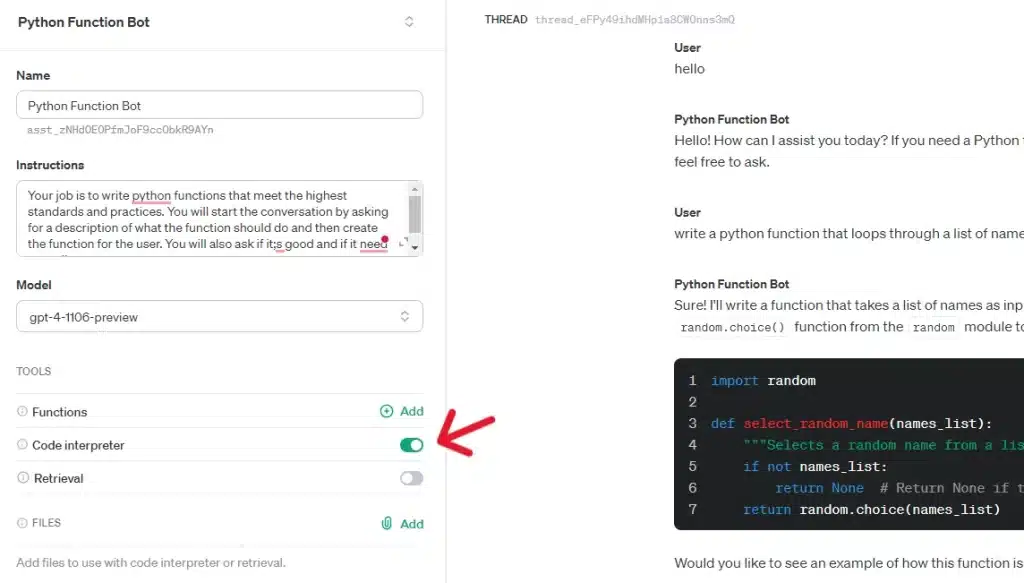
Code Interpreter enables the assistant to write and run code. This tool can process files with diverse data and formatting and generate files such as graphs.
Now, we will look at creating an assistant that makes Python functions based on the user’s requests. We will activate the “Code Interpreter” feature for this.
Let’s test with a prompt asking for a Python function.
9. Adding the Retrieval Capability with a custom Dataset
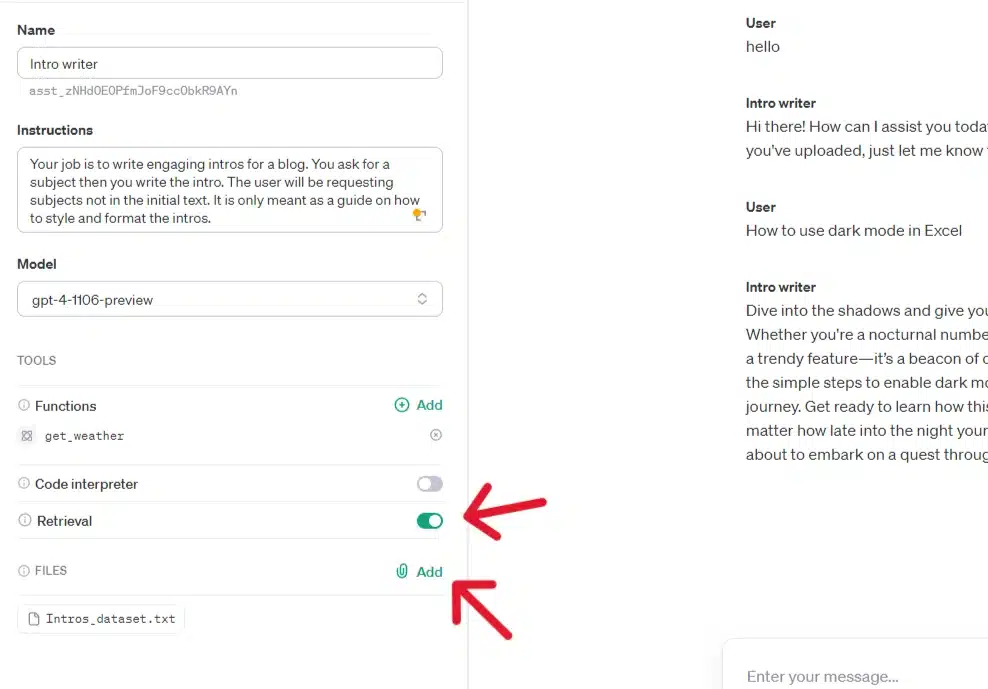
This game-changing feature empowers you to augment your assistant with custom datasets, allowing it to utilize and generate content from files you or your users upload.
Furthermore, Integrating user-specific data allows your assistant to deliver custom information based on individual needs.
To set up this remarkable functionality, provide detailed instructions that outline the desired behavior, then add a custom dataset by clicking the paperclip button and selecting a file from your computer.
Now, your assistant is equipped with these introductory examples and is ready to generate relevant content on-demand based on user requests.
Next up, let’s check out how they’ve seamlessly integrated language and vision.
What is GPT-4 Turbo with Vision

A groundbreaking addition to GPT-4 Turbo is its vision capability, GPT-4V or gpt-4-vision-preview in the API. This feature enables the model to interpret images, extending its applications beyond text-based inputs.
So, what’s the big deal with GPT-4 with Vision? Well, it can understand images better than ever before!
Key Highlights:
- Versatile Image Input Handling: GPT-4 Turbo can now process images, offering capabilities like generating captions, detailed image analysis, and document reading with figures.
- Accessibility Applications: Technologies like BeMyEyes are utilizing this to assist people with visual impairments in daily tasks.
- Affordable Pricing: The cost depends on the input image size. For example, processing a 1080×1080 pixel image costs $0.00765.
- Detailed Guidance: For more information on utilizing vision capabilities, refer to OpenAI’s vision guide.
- Availability and Usage: GPT-4 with Vision is accessible through the
gpt-4-vision-previewmodel and the updated Chat Completions API.
Quick Start Guide
You can now easily access GPT-4 Vision through the Completions API by selecting the gpt-4-vision-preview model.
This powerful new feature lets you include images in your user, system, and assistant messages using links or base64 encoded images. Ready to try it out?
Take a look at the following python script to get you started:
How to use GPT-4-vision (Python)
from openai import OpenAI
client = OpenAI()
response = client.chat.completions.create(
model="gpt-4-vision-preview",
messages=[
{
"role": "user",
"content": [
{"type": "text", "text": "What's in this image?" },
{
"type": "image_url",
"image_url": {
"url": "<https://upload.wikimedia.org/wikipedia/commons/thumb/d/dd/Gfp-wisconsin-madison-the-nature-boardwalk.jpg/2560px-Gfp-wisconsin-madison-the-nature-boardwalk.jpg>",
},
},
],
}
],
max_tokens=300,
)
print(response.choices[0])
This tech already has many excellent applications, like helping people with visual impairments. To learn more, check out OpenAI’s vision guide for detailed instructions on how to use GPT-4 with Vision.
Let’s take a look at what you can build with this tech.
What Can You Build with GPT4-Turbo?

GPT-4 Turbo marks a significant advancement in AI capabilities, offering unparalleled versatility and power for various applications. This state-of-the-art tool opens up a world of possibilities.
Here’s an exploration of what you can build with GPT-4 Turbo:
Diverse Applications of GPT-4 Turbo
- Advanced Chatbots: Harnessing the Chat Completions API, GPT-4 Turbo can power AI chatbots that mimic various personalities, from celebrities to historical figures, delivering natural language conversations, recommendations, and engaging content.
- Content Generation Powerhouse: Content marketing is a crucial aspect of modern businesses. GPT-4 Turbo’s content generation prowess allows enterprises to produce high-quality articles, blog posts, product descriptions, and marketing materials at scale.
- Revolutionary Image Generation: GPT-4 Turbo extends its capabilities to the visual realm, offering image creation and editing via natural language inputs. Users can generate or alter images, from logos to landscapes, using the Image Completions API and DALL-E model.
- Text-to-Speech Conversion: Transforming text into lifelike audio is seamless with GPT-4 Turbo’s TTS API. This feature is ideal for creating podcasts, audiobooks, voice assistants, and more. The OpenAI Platform here explains the various models and features available.
- Accessibility Solutions: The integration of GPT-4 Turbo’s vision capabilities, GPT-4V, can enable you to create assistive technologies for individuals with visual impairments. This includes applications like image description and interpretation, enhancing accessibility for a broader audience.
- In-depth Text Analysis: GPT-4 Turbo excels in extracting insights from text from sentiment analysis to text summarization. It can perform complex text analysis tasks using the Embeddings API and Moderation model.
GPT-4 Turbo unlocks unparalleled opportunities to transform industries and redefine possibilities, ushering in a new era of AI-driven innovation and creativity.
Now, let’s take a look a closer look at OpenAi’s current trajectory,
Advancing AI with GPT-4 Turbo and GPT-4V

With the introduction of GPT-4 Turbo and its visionary capability, GPT-4V, OpenAI has once again elevated the AI landscape to new heights. These groundbreaking advancements enhance AI’s efficiency, creativity, and safety and expand its applications across various domains.
GPT-4 Turbo’s extended knowledge base, expanded context window, versatile image processing, and cost-effectiveness make it a formidable tool.
Also, Its improved accuracy, safety features, and alignment with human values ensure responsible AI usage.
GPT-4 Turbo, combined with the vision capabilities of GPT-4V, opens up a world of possibilities.
From advanced chatbots to content generation, image editing, text-to-speech conversion, and in-depth text analysis, these technologies empower individuals and organizations to innovate and create like never before.
With ongoing research and development, OpenAI is set to refine and expand the capabilities of GPT-4 Turbo and its visionary counterpart, GPT-4V, making AI more accessible and functional for a wide range of applications.
Let’s consider the future of OpenAI’s products and their societal impacts.
OpenAI’s Vision for AI Integration

As OpenAI’s DevDay concluded, artificial intelligence’s future appeared bright and well within our grasp.
With the release of GPT-4 Turbo, OpenAI has brought a product to market and paved the way for an AI-integrated society. This vision, as seen by OpenAI, involves AI as a tool to enhance human abilities, increase productivity, and reflect human creativity and ingenuity.
The capacity of AI to act as a societal equalizer was evident in the testimonials shared during DevDay. It can help people with disabilities, offer educational support to overworked students, and much more.
However, with this power comes responsibility. As AI becomes more embedded in our daily lives, the importance of responsible AI deployment grows.
OpenAI’s approach to AI serves as a safeguard, ensuring that as AI capabilities expand, so does our understanding of its impacts and our preparedness to manage risks.
We believe, that the future of AI, is not one of displacement but collaboration.
It’s a future where AI and humanity co-evolve, where machines augment human potential, and where the very essence of what it means to be human is expanded by the capabilities that AI brings within our reach.
As OpenAI continues to push the boundaries of AI innovation, the future holds exciting prospects for AI-driven solutions across various fields.
In closing, let’s reflect on the key takeaways from this exploration.
Final Thoughts

Exciting times lie ahead! The dawn of a new era has arrived, and it’s clear that AI is not just approaching; it’s already here, transforming our world at an unprecedented pace.
OpenAI leads the charge in this revolution, constantly pushing the boundaries of what’s possible with cutting-edge technology. The implications for the future are vast—AI could reshape education, healthcare, creative industries, and more!
At DevDay, OpenAI demonstrated its unwavering commitment to innovation and making AI accessible and effective for all. Their GPT-4 Turbo doesn’t just peer into the future; it shapes it, one token at a time.
As we step into this new age, AI isn’t an outsider looking in but an integral part of our shared journey. Let’s embrace this transformative force and build a better, more inclusive future where collaboration, growth, and prosperity for all are within reach.
Have fun building!
Do you want to learn more about AI in the workplace? Checkout this great video on Integrating Powerbi with Chatgpt on the EnterpriseDNA Youtube Channel:
Frequently Asked Questions about GPT-4 Turbo
What is GPT-4 Turbo, and how is it different from GPT-4?
GPT-4 Turbo is an advanced version of the GPT-4 model, designed to offer improved performance and enhanced capabilities. It supports a larger context window, allowing it to process up to 128,000 tokens of text or information in a single prompt, equivalent to about 300 pages of text.
In addition to its enhanced text processing capabilities, GPT-4 Turbo supports vision, text-to-speech, and DALL-E 3. This makes it more powerful, updated, and affordable than the standard GPT-4 model.
How can I use GPT-4 Turbo, and what are the benefits?
GPT-4 Turbo can be used through the Chat Completion API, which is an API dedicated to interacting with the GPT-4 Turbo and GPT-4 models. This API provides a simple and consistent interface for creating conversational applications.
The benefits of using GPT-4 Turbo include its ability to solve complex problems, generate creative and collaborative content, and provide safer and more valuable responses. Its enhanced capabilities make it ideal for various use cases across multiple industries.
How can I customize GPT-4 Turbo, and what are the options?
GPT-4 Turbo can be customized by creating your deployments of the model, which allows you to specify various parameters and settings. These options include choosing the model size, data domain, fine-tuning method, safety and alignment features, and pricing plan.
Additionally, you can use the Chatgpt Plus service, a web-based platform for creating and managing custom GPT-4 Turbo deployments, which provides more control over your model’s settings and performance.
How can I access GPT-4 Turbo, and what are the requirements?
GPT-4 Turbo can be accessed through the Chat Completion API, which requires an account with ChatGPT, the official GPT-4 Turbo service provider. You will also need a valid API key and a subscription plan to use the service.
OpenAI has implemented safety measures to ensure responsible and ethical usage of the model, and users are encouraged to provide feedback on problematic outputs to help improve the model’s performance and reliability.
What are the features and capabilities of GPT-4 Turbo, and how are they different from other language models?
GPT-4 Turbo is a state-of-the-art language model that can generate natural and coherent text, images, and audio from any input. It can also understand and respond to natural language queries, commands, and conversations.
GPT-4 Turbo’s features and capabilities set it apart from other language models by supporting a larger context window, vision, text-to-speech, and DALL-E 3. These enhancements make it more versatile and capable of handling complex tasks and applications.
What are the use cases for GPT-4 Turbo, and how can it benefit different industries?
GPT-4 Turbo has various use cases across multiple industries, including natural language understanding and generation, healthcare, finance, education, and creative fields.
It can benefit industries by enabling advanced applications such as chatbots, virtual assistants, content generation, medical diagnosis, data analysis, personalized learning, art generation, and more.
GPT-4 Turbo can help organizations optimize their operations, improve their products and services, and enhance customer experiences by providing a powerful and versatile language model.
Is GPT-4 Turbo safe to use, and what measures are in place to ensure ethical usage?
OpenAI has implemented safety measures to make GPT-4 Turbo safer, including testing and fine-tuning to reduce harmful and biased outputs. OpenAI provides guidelines and best practices for responsible and ethical usage of the model.
You are encouraged to provide feedback on problematic outputs, and OpenAI continuously iterates on the model to improve its safety and reliability. By taking these measures, OpenAI aims to ensure that GPT-4 Turbo is used in a manner that respects privacy, fairness, and the public interest.
What are the pricing options for GPT-4 Turbo, and is a free trial available?
OpenAI offers different pricing plans for GPT-4 Turbo, including pay-as-you-go and subscription-based options. The pricing may vary depending on factors like usage volume and customizations. OpenAI may offer a free trial or limited access period for you to explore its capabilities.











